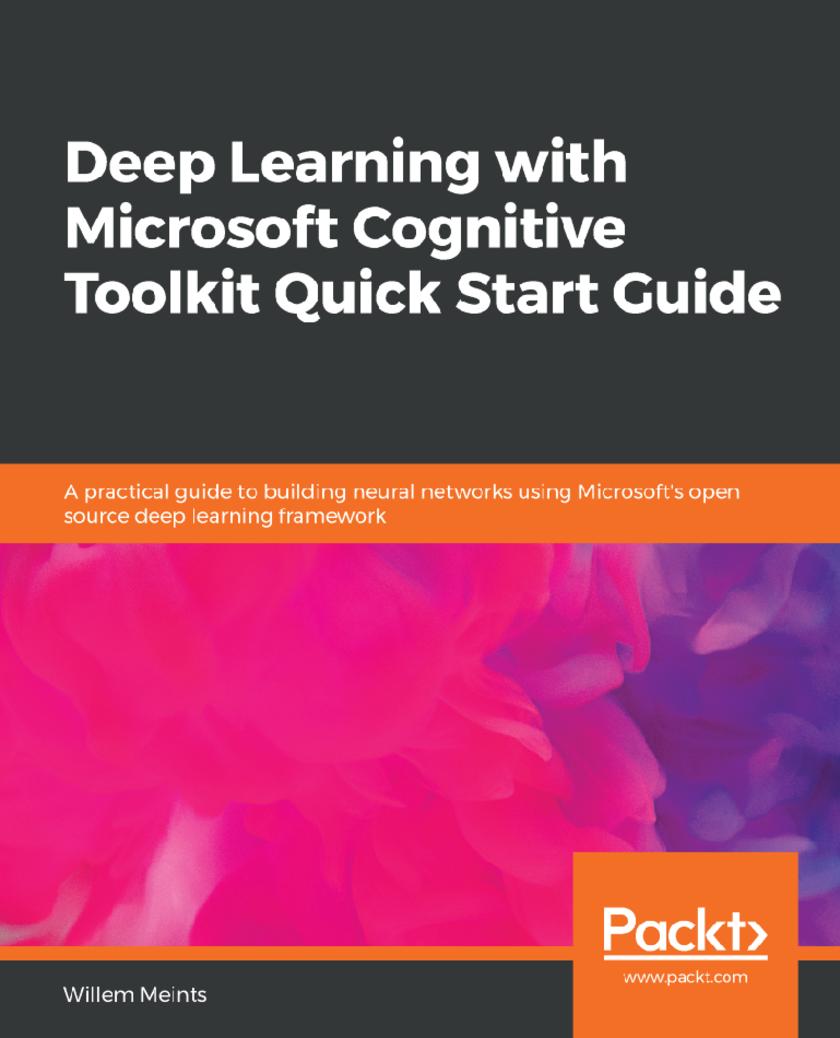
Deep Learning with Microsoft Cognitive Toolkit Quick Start Guide
¥54.49
Learn how to train popular deep learning architectures such as autoencoders, convolutional and recurrent neural networks while discovering how you can use deep learning models in your software applications with Microsoft Cognitive Toolkit Key Features * Understand the fundamentals of Microsoft Cognitive Toolkit and set up the development environment * Train different types of neural networks using Cognitive Toolkit and deploy it to production * Evaluate the performance of your models and improve your deep learning skills Book Description Cognitive Toolkit is a very popular and recently open sourced deep learning toolkit by Microsoft. Cognitive Toolkit is used to train fast and effective deep learning models. This book will be a quick introduction to using Cognitive Toolkit and will teach you how to train and validate different types of neural networks, such as convolutional and recurrent neural networks. This book will help you understand the basics of deep learning. You will learn how to use Microsoft Cognitive Toolkit to build deep learning models and discover what makes this framework unique so that you know when to use it. This book will be a quick, no-nonsense introduction to the library and will teach you how to train different types of neural networks, such as convolutional neural networks, recurrent neural networks, autoencoders, and more, using Cognitive Toolkit. Then we will look at two scenarios in which deep learning can be used to enhance human capabilities. The book will also demonstrate how to evaluate your models' performance to ensure it trains and runs smoothly and gives you the most accurate results. Finally, you will get a short overview of how Cognitive Toolkit fits in to a DevOps environment What you will learn * Set up your deep learning environment for the Cognitive Toolkit on Windows and Linux * Pre-process and feed your data into neural networks * Use neural networks to make effcient predictions and recommendations * Train and deploy effcient neural networks such as CNN and RNN * Detect problems in your neural network using TensorBoard * Integrate Cognitive Toolkit with Azure ML Services for effective deep learning Who this book is for Data Scientists, Machine learning developers, AI developers who wish to train and deploy effective deep learning models using Microsoft CNTK will find this book to be useful. Readers need to have experience in Python or similar object-oriented language like C# or Java.
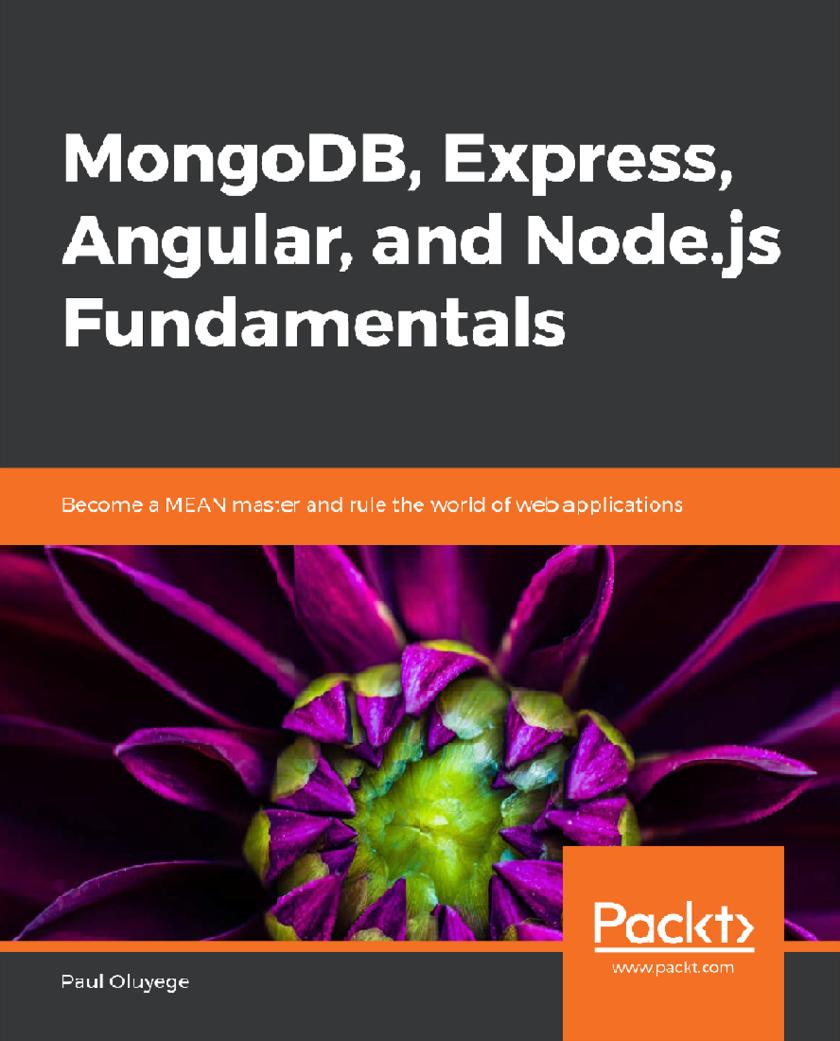
MongoDB, Express, Angular, and Node.js Fundamentals
¥63.21
Build fast, robust, and maintainable modern full-stack web applications using MongoDB, Express, Angular, and Node.js. Key Features * Build highly scalable, asynchronous, and event-driven APIs * Develop a user authentication system with MEAN * Build a full-fledged application using the MEAN stack Book Description MongoDB, Express, Angular and Node.js Fundamentals is a practical guide to the tried-and-true production-ready MEAN stack, with tips and best practices. The book begins by demystifying the MEAN architecture. You’ll take a look at the features of the JavaScript libraries, technologies, and frameworks that make up a MEAN stack. With this book, you'll not only learn how to develop highly scalable, asynchronous, and event-driven APIs quickly with Express and Node.js, but you'll also be able put your full-stack skills to use by building two full-fledged MEAN applications from scratch. You’ll understand how to build a blogging application using the MEAN stack and get to grips with user authentication using MEAN. As you progress through the chapters, you’ll explore some old and new features of Angular, such as pipes, reactive forms, modules and optimizing apps, animations and unit testing, and much more. By the end of the book, you’ll get ready to take control of the MEAN stack and transform into a full-stack JavaScript developer, developing efficient web applications using Javascript technologies. What you will learn * Understand the MEAN architecture * Create RESTful APIs to complete CRUD tasks * Build a blogging application with basic features * Describe best practices to secure node applications * Implement authentication and authorization * Creating simple animations using Angular * Perform unit testing on Angular applications Who this book is for If you are a beginner or intermediate frontend developer who wants to become full-stack JavaScript developer, this book is ideal for you. You'll need some prior exposure to MongoDB as we skim over its basics before getting straight to work.
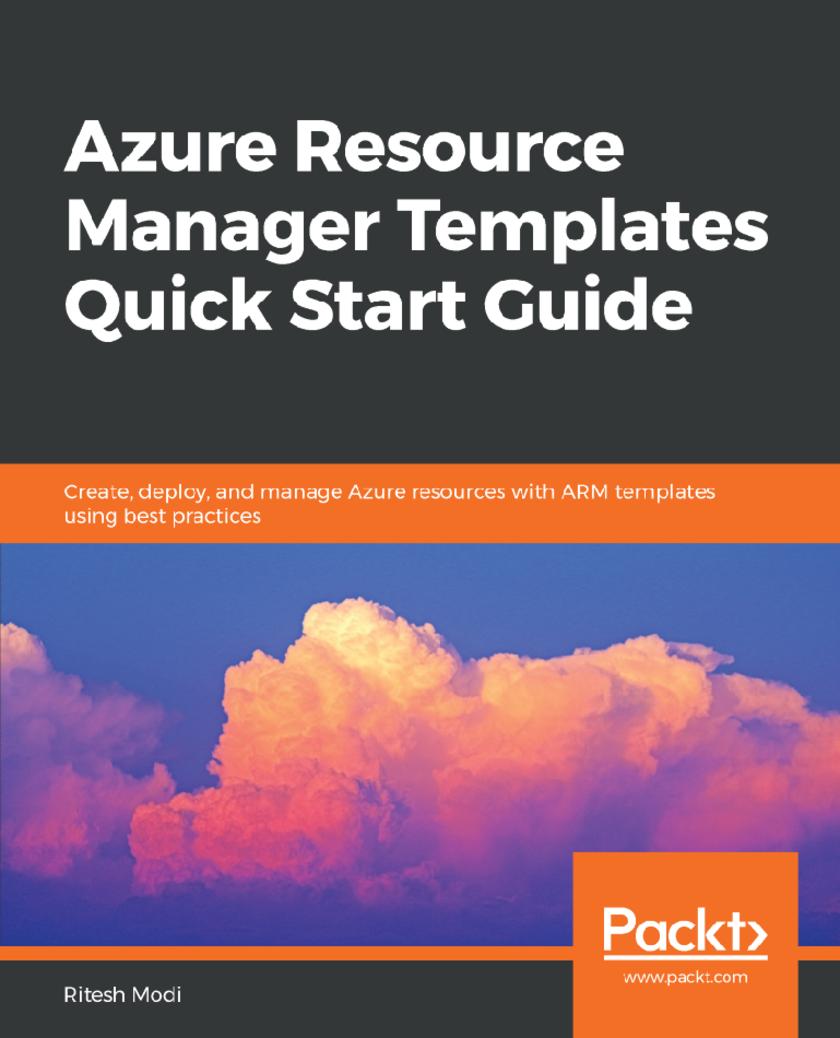
Azure Resource Manager Templates Quick Start Guide
¥54.49
Compose and decompose ARM templates and use advanced concepts like looping, conditions, dependencies, PowerShell and Desired State Configuration. Key Features * Design, implement, and unit test ARM templates * Develop and deploy ARM templates following security best practices Book Description Azure Resource Manager (ARM) templates are declarations of Azure resources in the JSON format to provision and maintain them using infrastructure as code. This book gives practical solutions and examples for provisioning and managing various Azure services using ARM templates. The book starts with an understanding of infrastructure as code, a refresher on JSON, and then moves on to explain the fundamental concepts of ARM templates. Important concepts like iteration, conditional evaluation, security, usage of expressions, and functions will be covered in detail. You will use linked and nested templates to create modular ARM templates. You will see how to create multiple instances of the same resources, how to nest and link templates, and how to establish dependencies between them. You will also learn about implementing design patterns, secure template design, the unit testing of ARM templates, and adopting best practices. By the end of this book, you will understand the entire life cycle of ARM templates and their testing, and be able to author them for complex deployments. What you will learn * Understand the foundations of ARM templates including nested and linked templates * Design, create, and unit test ARM templates using best practices * Learn about conditional deployments, looping, Custom Script Extensions using PowerShell, Bash, and DSC * Implement design patterns related to ARM templates * Run post-deployment PowerShell and Desired State Configuration scripts * Create solutions and deploy them on Azure using ARM templates Who this book is for This books is for developers, DevOps engineers, and architects who have experience in Azure.
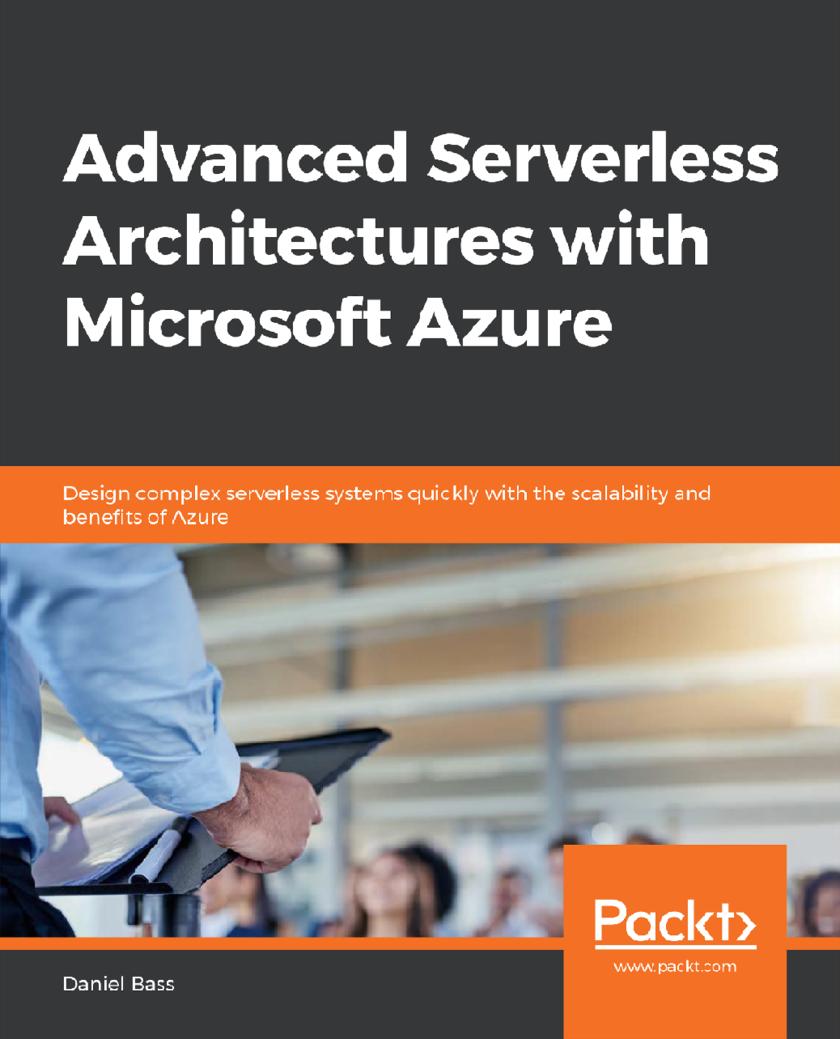
Advanced Serverless Architectures with Microsoft Azure
¥63.21
Build complex, observable, and fault-tolerant serverless systems easily on Microsoft Azure. Key Features * Use serverless systems to help you fulfill complex requirements * Develop your knowledge of Azure Microsoft Serverless * Understand concepts with a hands-on approach and helpful examples Book Description Advanced Serverless Architectures with Microsoft Azure redefines your experience of designing serverless systems. It shows you how to tackle challenges of varying levels, not just the straightforward ones. You'll be learning how to deliver features quickly by building systems, which retain the scalability and benefits of serverless. You'll begin your journey by learning how to build a simple, completely serverless application. Then, you'll build a highly scalable solution using a queue, load messages onto the queue, and read them asynchronously. To boost your knowledge further, the book also features durable functions and ways to use them to solve errors in a complex system. You'll then learn about security by building a security solution from serverless components. Next, you’ll gain an understanding of observability and ways to leverage application insights to bring you performance benefits. As you approach the concluding chapters, you’ll explore chaos engineering and the benefits of resilience, by actively switching off a few of the functions within a complex system, submitting a request, and observing the resulting behavior. By the end of this book, you will have developed the skills you need to build and maintain increasingly complex systems that match evolving platform requirements. What you will learn * Understand what true serverless architecture is * Study how to extend and scale architectures until they become ‘complex' * Implement durable functions in your design * Improve the observability of your serverless architecture * Implement security solutions using serverless services * Learn how to ‘practise' chaos engineering in production Who this book is for Advanced Serverless Architectures with Microsoft Azure is is ideal if you want to build serverless systems with fewer outages and high performance using Azure. Familiarity with the C# syntax and Azure Functions and ARM templates will help you to benefit more from this book. Prior knowledge of basic front-end development, HTML JS, and CSS is beneficial but not essential. Some DevOps knowledge is also beneficial but not essential.
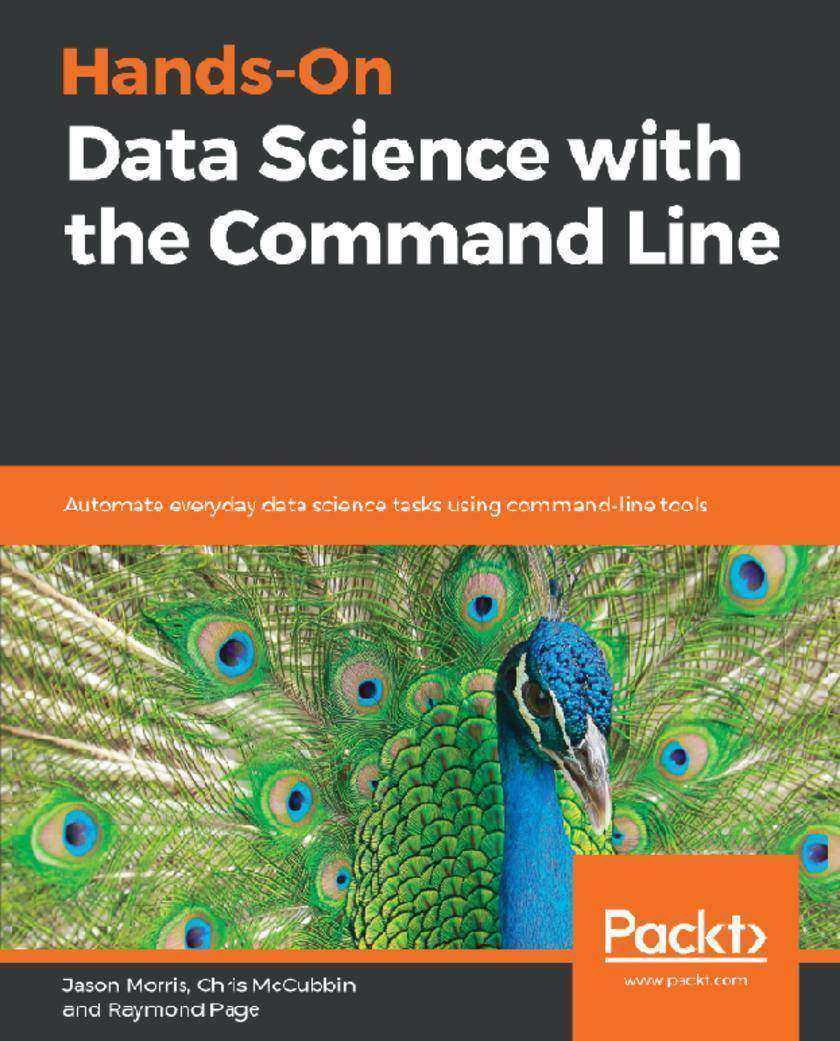
Hands-On Data Science with the Command Line
¥54.49
Big data processing and analytics at speed and scale using command line tools. Key Features * Perform string processing, numerical computations, and more using CLI tools * Understand the essential components of data science development workflow * Automate data pipeline scripts and visualization with the command line Book Description The Command Line has been in existence on UNIX-based OSes in the form of Bash shell for over 3 decades. However, very little is known to developers as to how command-line tools can be OSEMN (pronounced as awesome and standing for Obtaining, Scrubbing, Exploring, Modeling, and iNterpreting data) for carrying out simple-to-advanced data science tasks at speed. This book will start with the requisite concepts and installation steps for carrying out data science tasks using the command line. You will learn to create a data pipeline to solve the problem of working with small-to medium-sized files on a single machine. You will understand the power of the command line, learn how to edit files using a text-based and an. You will not only learn how to automate jobs and scripts, but also learn how to visualize data using the command line. By the end of this book, you will learn how to speed up the process and perform automated tasks using command-line tools. What you will learn * Understand how to set up the command line for data science * Use AWK programming language commands to search quickly in large datasets. * Work with files and APIs using the command line * Share and collect data with CLI tools * Perform visualization with commands and functions * Uncover machine-level programming practices with a modern approach to data science Who this book is for This book is for data scientists and data analysts with little to no knowledge of the command line but has an understanding of data science. Perform everyday data science tasks using the power of command line tools.
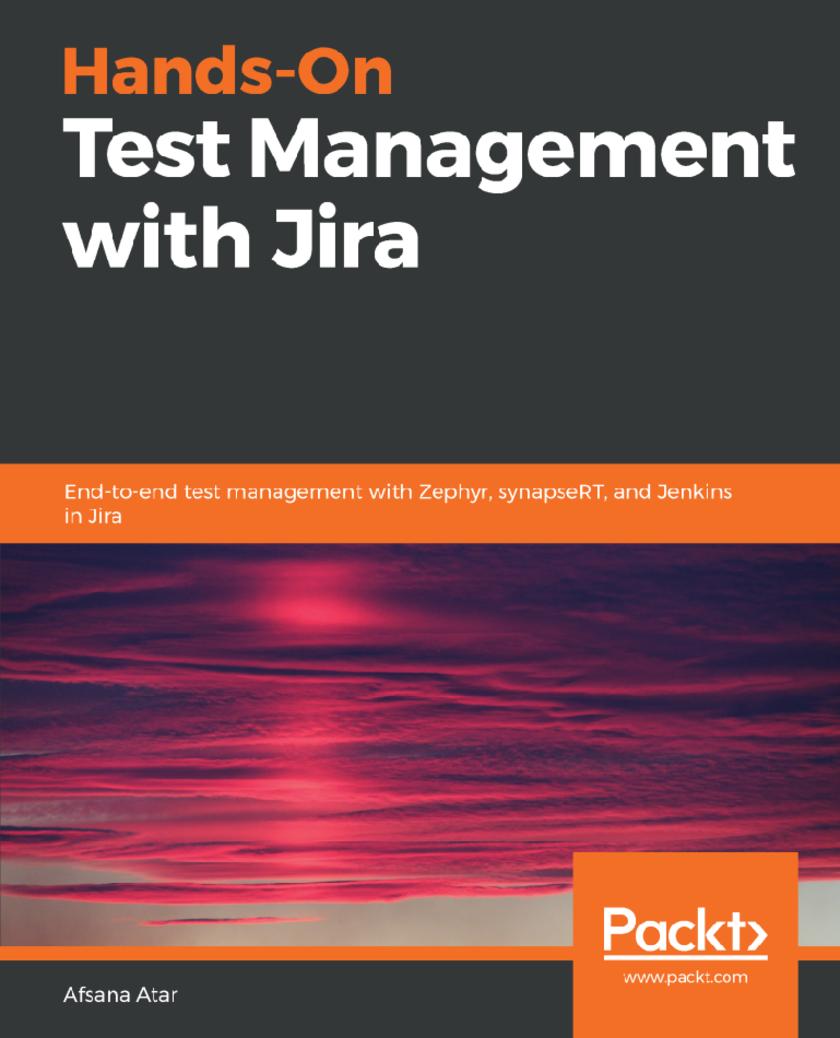
Hands-On Test Management with Jira
¥54.49
Learn best practices for testing with Jira and model industry workflows that can be used during the software development lifecycle Key Features * Integrate Jira with test management tools such as Zephyr, Test Management, and SynapseRT * Understand test case management, traceability, and test execution with reports * Implement continuous integration using Jira, Jenkins, and automated testing tools Book Description Hands-On Test Management with Jira begins by introducing you to the basic concepts of Jira and takes you through real-world software testing processes followed by various organizations. As you progress through the chapters, the book explores and compares the three most popular Jira plugins—Zephyr, Test Management, and synapseRT. With this book, you’ll gain a practical understanding of test management processes using Jira. You’ll learn how to create and manage projects, create Jira tickets to manage customer requirements, and track Jira tickets. You’ll also understand how to develop test plans, test cases, and test suites, and create defects and requirement traceability matrices, as well as generating reports in Jira. Toward the end, you’ll understand how Jira can help the SQA teams to use the DevOps pipeline for automating execution and managing test cases. You’ll get to grips with configuring Jira with Jenkins to execute automated test cases in Selenium. By the end of this book, you’ll have gained a clear understanding of how to model and implement test management processes using Jira. What you will learn * Understand QMS to effectively implement quality systems in your organization * Explore a business-driven structured approach to Test Management using TMap NEXT * Implement different aspects of test planning, test strategy, and test execution * Organize and manage Agile projects in Scrum and Kanban * Uncover Jira plugins available in the Atlassian Marketplace for testing and project management * Configure a DevOps pipeline for continuous integration using Jira with Jenkins Who this book is for If you’re a quality assurance professional, software project manager, or test manager interested in learning test management best practices in your team or organization, this book is for you. Prior knowledge of test management and Jenkins will be beneficial in understanding the concepts covered in this book.
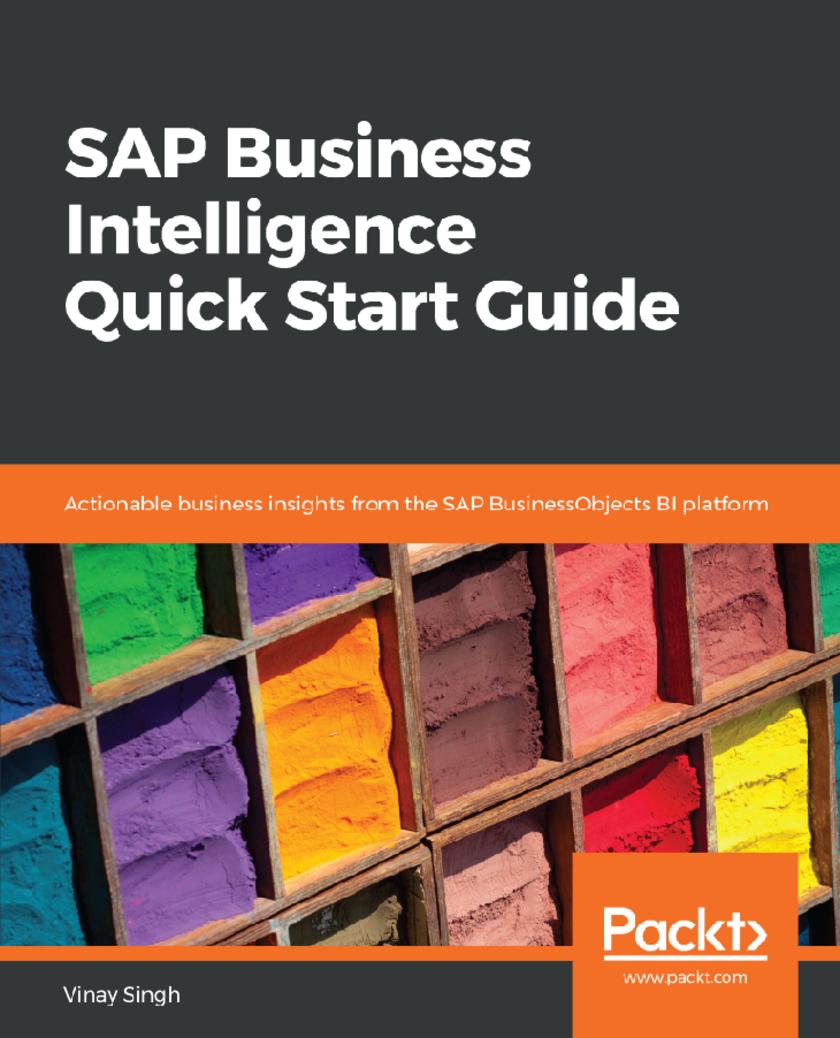
SAP Business Intelligence Quick Start Guide
¥63.21
Designing and deploying solutions using the SAP BusinessObjects Business Intelligence platform 4.2. Key Features * Get up and running with the SAP BusinessObjects Business Intelligence platform * Perform effective data analysis and visualization for actionable insights * Enhance your BI strategy by creating different types of reports and dashboards using SAP BusinessObjects Book Description The SAP BusinessObjects Business Intelligence platform is a powerful reporting and analysis tool. This book is the ideal introduction to the SAP BusinessObjects Business Intelligence platform, introducing you to its data visualization, visual analytics, reporting, and dashboarding capabilities. The book starts with an overview of the BI platform and various data sources for reporting. Then, we move on to looking at data visualization, analysis, reporting, and analytics using BusinessObjects Business Intelligence tools. You will learn about the features associated with reporting, scheduling, and distribution and learn how to deploy the platform. Toward the end, you will learn about the strategies and factors that should be considered during deployment. By the end, you will be confident working with the SAP BusinessObjects Business Intelligence platform to deliver better insights for more effective decision making. What you will learn * Work with various tools to create interactive data visualization and analysis * Query, report, and analyze with SAP Business Objects Web Intelligence * Create a report in SAP Crystal Reports for Enterprise * Visualize and manipulate data using an SAP Lumira Storyboard * Deep dive into the workings of the SAP predictive analytics tool * Deploy and configure SAP BO Intelligence platform 4.2 Who this book is for This book is for Business Intelligence professionals and existing SAP ecosystem users who want to perform effective Business Intelligence using SAP BusinessObjects.
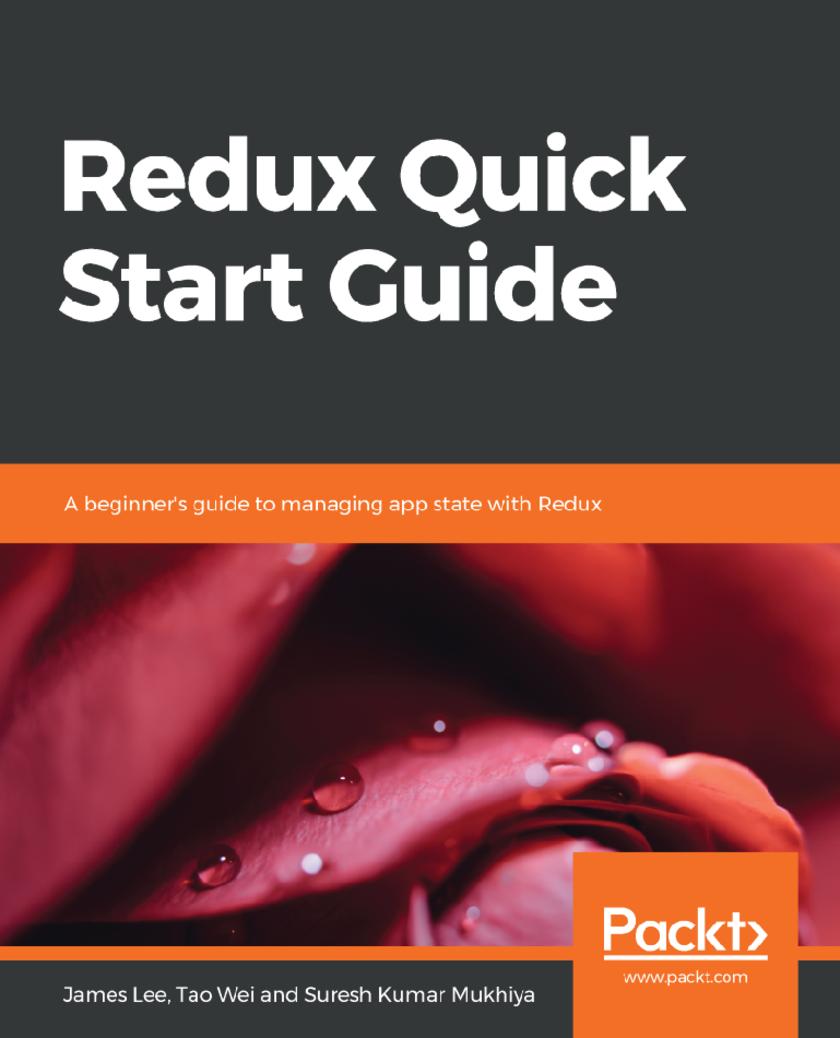
Redux Quick Start Guide
¥54.49
Integrate Redux with React and other front-end JavaScript frameworks efficiently and manage application states effectively Key Features * Get better at building web applications with state management using Redux * Learn the fundamentals of Redux to structure your app more efficiently * This guide will teach you develop complex apps that would be easier to maintain Book Description Starting with a detailed overview of Redux, we will follow the test-driven development (TDD) approach to develop single-page applications. We will set up JEST for testing and use JEST to test React, Redux, Redux-Sage, Reducers, and other components. We will then add important middleware and set up immutableJS in our application. We will use common data structures such as Map, List, Set, and OrderedList from the immutableJS framework. We will then add user interfaces using ReactJS, Redux-Form, and Ant Design. We will explore the use of react-router-dom and its functions. We will create a list of routes that we will need in order to create our application, and explore routing on the server site and create the required routes for our application. We will then debug our application and integrate Redux Dev tools. We will then set up our API server and create the API required for our application. We will dive into a modern approach to structuring our server site components in terms of Model, Controller, Helper functions, and utilities functions. We will explore the use of NodeJS with Express to build the REST API components. Finally, we will venture into the possibilities of extending the application for further research, including deployment and optimization. What you will learn * Follow the test-driven development (TDD) approach to develop a single-page application * Add important middleware, such as Redux store middleware, redux-saga middleware, and language middleware, to your application * Understand how to use immutableJS in your application * Build interactive components using ReactJS * Configure react-router-redux and explore the differences between react-router-dom and react-router-redux * Use Redux Dev tools to debug your application * Set up our API server and create the API required for our application Who this book is for This book is meant for JavaScript developers interesting in learning state management and building easy to maintain web applications.
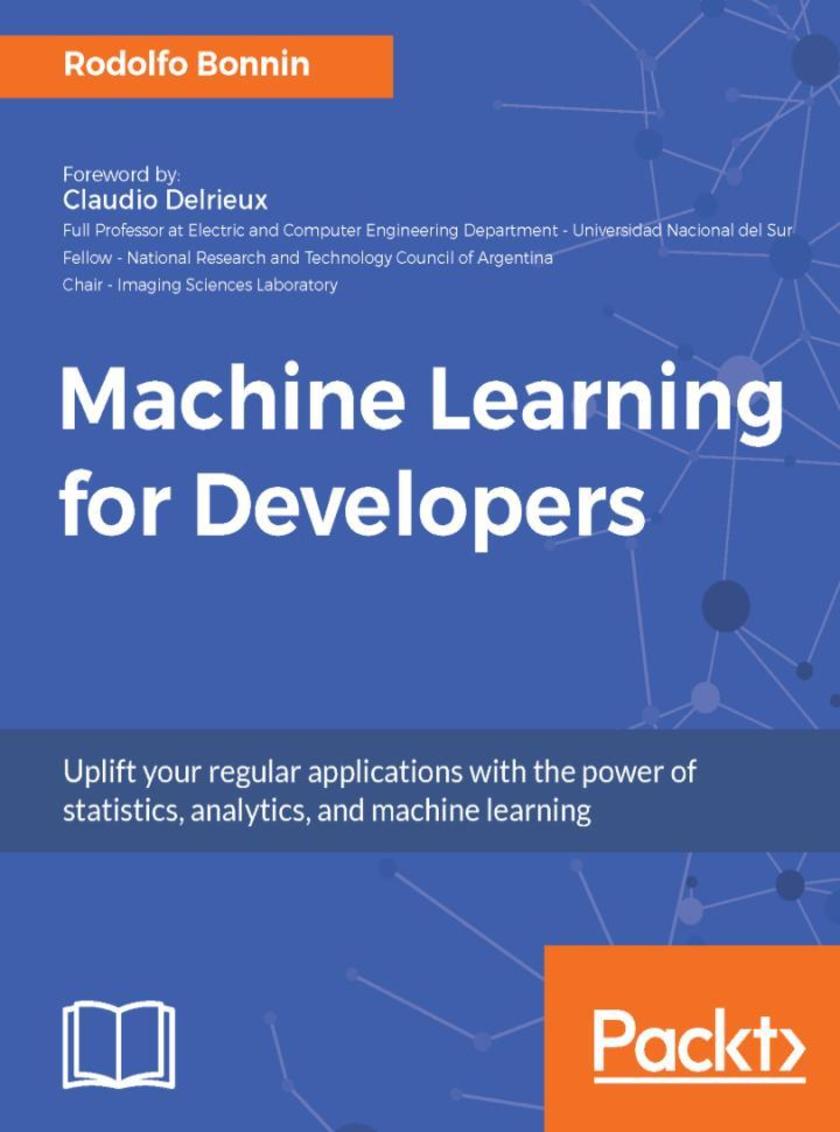
Machine Learning for Developers
¥190.48
Your one-stop guide to becoming a Machine Learning expert. About This Book ? Learn to develop efficient and intelligent applications by leveraging the power of Machine Learning ? A highly practical guide explaining the concepts of problem solving in the easiest possible manner ? Implement Machine Learning in the most practical way Who This Book Is For This book will appeal to any developer who wants to know what Machine Learning is and is keen to use Machine Learning to make their day-to-day apps fast, high performing, and accurate. Any developer who wants to enter the field of Machine Learning can effectively use this book as an entry point. What You Will Learn ? Learn the math and mechanics of Machine Learning via a developer-friendly approach ? Get to grips with widely used Machine Learning algorithms/techniques and how to use them to solve real problems ? Get a feel for advanced concepts, using popular programming frameworks. ? Prepare yourself and other developers for working in the new ubiquitous field of Machine Learning ? Get an overview of the most well known and powerful tools, to solve computing problems using Machine Learning. ? Get an intuitive and down-to-earth introduction to current Machine Learning areas, and apply these concepts on interesting and cutting-edge problems. In Detail Most of us have heard about the term Machine Learning, but surprisingly the question frequently asked by developers across the globe is, “How do I get started in Machine Learning?”. One reason could be attributed to the vastness of the subject area because people often get overwhelmed by the abstractness of ML and terms such as regression, supervised learning, probability density function, and so on. This book is a systematic guide teaching you how to implement various Machine Learning techniques and their day-to-day application and development. You will start with the very basics of data and mathematical models in easy-to-follow language that you are familiar with; you will feel at home while implementing the examples. The book will introduce you to various libraries and frameworks used in the world of Machine Learning, and then, without wasting any time, you will get to the point and implement Regression, Clustering, classification, Neural networks, and more with fun examples. As you get to grips with the techniques, you’ll learn to implement those concepts to solve real-world scenarios for ML applications such as image analysis, Natural Language processing, and anomaly detections of time series data. By the end of the book, you will have learned various ML techniques to develop more efficient and intelligent applications. Style and approach This book gives you a glimpse of Machine Learning Models and the application of models at scale using clustering, classification, regression and reinforcement learning with fun examples. Hands-on examples will be presented to understand the power of problem solving with Machine Learning and Advanced architectures, software installation, and configuration.
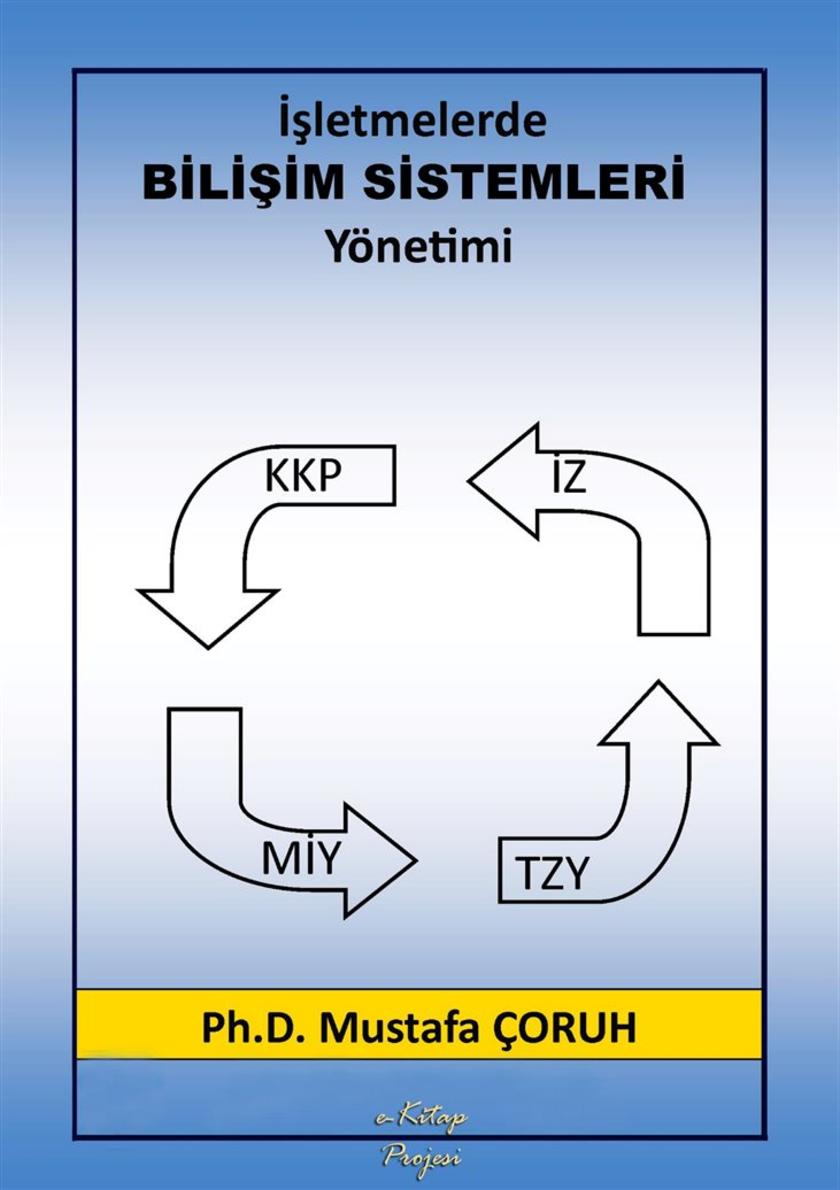
??letmelerde Bili?im Sistemleri Y?netimi
¥28.29
Bu kitap “Bili?im Teknolojileri (BT) Ekonomisi ve Toplumu” adl? ilk kitab?mda BT’lerin hayat?m?z? de?i?tirdi?i d?rt yerdeki (Evde, okulda, kentlerde ve i?yerlerinde) incelememin ü?üncüsü olan i?yerlerindeki etkileri üzerinedir. Daha ?nce “Bili?im Teknolojileri Destekli ??renim” ve “Bili?im Kentleri ?a??” adl? kitaplar?mda BT’lerin okul ve kent ya?am?ndaki etkilerini detaylar?yla inceledim. 30 y?l? a?an i? hayat?mda BT’lerin i? dünyas?n? ve y?netimini kurulan Bili?im Sistemleri (BS) vas?tas?yla nas?l de?i?tirdi?ini ya?ayarak bildi?imden bu konu i?in uzun bir ara?t?rma yapmak zorunda oldu?umu biliyordum. Di?er yandan 592 sayfay? bulan bu ara?t?rmada sayfa s?n?rlamas? amac?yla BS’lerle ilgili baz? konular? (?rne?in Toplam Kalite Y?netimi, 6 Sigma, Simülasyon, Gereksinim Y?netimi, Programlama vs.) kitap haricinde b?rakmak zorunda kald???m? da belirtmeliyim. Bu kitapta a??rl?kl? olarak BT’lerin i?letmelerdeki uygulamas? olan Bili?im Sistemlerinden bahsettim ?ünkü BT’ler BS’ler vas?tas?yla i?letmeleri ve y?netimlerini etkilemektedirler. Dünyan?n en h?zl? bilgisayar?n? veya en yeni ak?ll? telefonunu sat?n alman?z veya en h?zl? internet eri?imine sahip olman?z i?letmeye ekstra bir katk? sa?lamamaktad?r. Ne zaman ki bu ara?lar i?letme süre?lerinin otomasyonunu sa?layan BS’ler i?inde kullan?lmaya ba?lan?nca i?letme rekabet?ili?ine, kar?na veya maliyetlerinin kontrolüne bir faydas? olabilmektedir. Bu yüzden i?letme y?neticilerinin bilmesi gereken en ?nemli konu BT ara?lar?n? ve di?er yeni teknolojik ara?lar? i?letme i? süre?lerinde nas?l verimli ve etkin bir ?ekilde kullanabileceklerini bilmeleridir. Bilmiyorlarsa da bilenleri i?e almalar?d?r. En son yenilikleri kullanmak belki de firmaya zarar vermekte veya rekabet dezavantaj? olu?turmaktad?r. Bu a??dan ?ncelikle bugün BS’lerin hangi i?letme fonksiyonlar?n? nas?l etkiledi?ini ve gelecekte nas?l etkileyebilece?ini anlatmaya ?al??t?m. ?rne?in, Yapay Zek? (YZ) ve onun en ?nemli uygulamalar?ndan birisi olan Robotiklerin i? süre?leri ve i?letme y?netimlerini yak?n bir zamanda nas?l etkileyebilece?inden bahsettim. Endüstri 4.0 teknolojileriyle insan ve makinelerin birlikte nas?l verimli ve etkin bir ?ekilde ?al??malar? gerekti?i insanl???n ve i?letmelerin ?nünde duran en ?nemli konulardan birisi oldu?unu s?ylemek fazla fütüristik bir kehanet de?il. Kitapta ??letmelerde kullan?lan Bili?im Sistemleriyle ilgili temel konulara bir bütünlük i?inde bakarken kitab?n arka kapa??ndaki sorular? cevaplamaya ?al??t?m. Bili?im Sistemleri aras?ndaki ili?kileri, farkl?l?klar?n? ve birbirlerini nas?l tamamlad?klar?n? sat?r aralar?nda vermeye ?al??t?m. BS’lerle i?letme süre?lerinin nas?l bütünle?tirilece?i i?letmelerdeki en yeni y?netim sorunlar? oldu?u unutulmamal?d?r. ??letme y?neticilerinin hat?rlamas? gereken bir ?nemli konuda BS’lerin bir yaz?l?m ve de?i?im projesi olmas?d?r. Bili?im Teknolojileri ve Sistemleri okuryazarl??? i?in bilinmesi gereken baz? teknik, bilimsel ve teknolojik terimlerin k?saltmalar?n? kitapta ilk kullan?ld???nda uzun ve k?salt?lm?? yaz?l?mlar?yla birlikte kulland?m. ?rne?in Veritabanlar? (VT), Veri ??leme Sistemi (V?S), Kurumsal ?? Zek?s? (K?Z), Y?netim Bili?im Sistemi (YBS), Karar Destek Sistemi (KDS), Veri Ambar? (VA), Veri Madencili?i (VM), Kurumsal Kaynak Planlama (KKP), Mü?teri ?li?kileri Y?netimi (M?Y), Tedarik Zinciri Y?netimi (TZY), Ofis Otomasyon Sistemi (OOS) ve Bilgi Y?netimi (BY) en fazla kulland???m k?saltmalard?r. Kitap sonundaki “K?saltmalar” tablosunda tüm k?saltmalar? listelemeye ?al??t?m. Ayr?ca bir?ok terimin ?ngilizcesini de parantez i?inde vermeye ?al??t?m. ?rne?in Veritabanlar? (Database) gibi. Dilimize girmi? bir?ok yabanc? teknik terim ve kelimelerin Türk?esini kullanmaya ?zen g?sterdim ve bu yabanc? kelimeleri de parantez i?inde yazd?m. Ayr?ca BT’lerin BS’ler vas?tas?yla i?letmeler üzerindeki etkilerini incelerken, birazda üniversitelerimizde YBS b?lümlerinde okutulan BS’lerle ilgili uzmanl?k konular?n?n ?o?unu ?zetlemeye ?al??t?m. ?zellikle i? Dünyas?nda ?ok?a kullan?lan baz? konulara (V?S, YBS, KDS, VT, VA, BY, US, KKP, M?Y, Sistem yakla??m?, SGYD vs.) biraz detayl? bakmaya ?al??t?m. K?sacas? kitapta i?letmelerde Bili?im Teknolojileri ve Sistemleri denince akla gelebilecek bir?ok konuya de?inmeye ?al??t?m. Bu yüzden bu kitab?n BS alan?nda bir elkitab? veya kaynak kitap olarak dü?ünülmesinde fayda vard?r. Bu kitapta ilkokul ??retmenim Say?n ?erare ?zya?c? han?mdan, en son Doktora tez dan??man?m say?n Prof. Dr. Len Rogers’a kadar yüzlerce ki?inin eme?inin oldu?u unutulmamal?d?r. 1984’ten beri Türkiye, ABD, Kanada ve ?ngiltere de ?al??t???m veya dan??manl???n? yapt???m onlarca firma ve mü?terilerimin katk?lar?n? unutabilir miyim? Burada isim isim te?ekkür edemedi?im ancak bu kitab?n yaz?lmas?nda katk?lar? olan daha yüzlerce ki?i var, hepsine en i?ten dileklerimle te?ekkür ederim. Hayatta neyi tek ba??m?za yapabiliyoruz ki? Bu kitap 30+ y?ld?r üretim planlama ve stok kontrol müdürü, metot etüdcü, sistem analisti, programc?, VT tasar?mc?s?
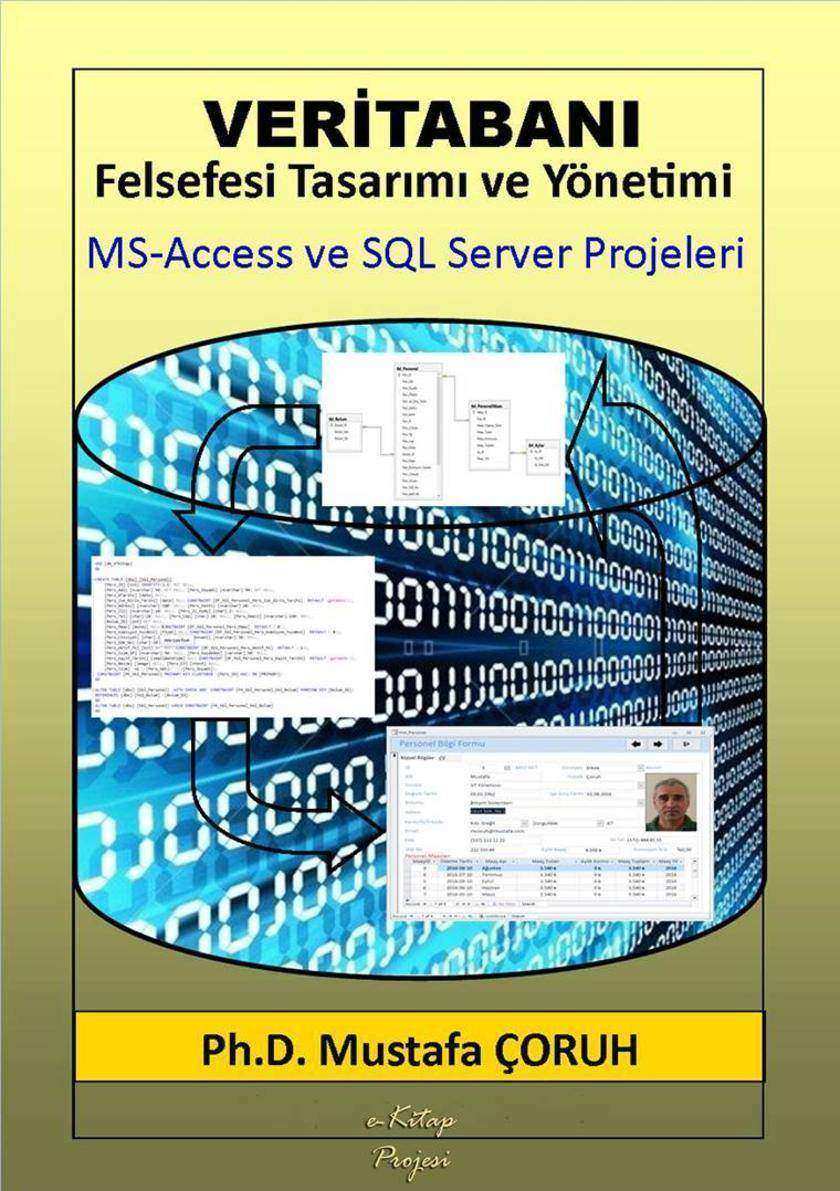
Veritaban?: "Felsefesi, Tasar?m? ve Y?netimi": MS-Access ve SQL Server Projeleri
¥27.88
“Bili?im Teknolojileri” konusunda yazd???m ü? kitaptan sonra as?l uzmanl?k alan?m olan veritabanlar? konusunda uzun y?llar ?nce yazmaya ba?lay?p bitiremedi?im daha do?rusu bas?lmayan bu kitab? güncelleyerek yeniden yazmaya karar vermek benim a??mdan yeni bir heyecan oldu. 1980’lerde COBOL ile ba?layan ve 1990’da dBase ve Informix’le devam eden veritaban? tecrübelerim, 1995 sonras? MS-Access ve SQL Server yard?m?yla geli?tirdi?im 100’e yak?n veritaban? uygulama programlar?yla devam etti. 1996’da Dallas’ta MCI Systemhouse’da FrontPage ve Access 95’le veritaban?na dayal? Intranet web siteleri geli?tiren ilk ki?ilerden birisi ben oldum. 1999’da Movo Mediya’da ilk ??p?atan web sitesi www.dating.com'un?arkas?ndaki SQL Server veritabanlar?n? tasarlayan ve y?neten ki?i de bendim. 2000 y?l?nda Aris Genesis Intermedia Inc’de web tabanl? muhasebe program?n?n arkas?ndaki SQL Server veritaban? tasar?mc?lar?ndan biriside bendim. Büyük al??veri? merkezlerinde g?rülen Kiosk’lar?n SQL Server tabanl? ilk uygulamas?n? Los Angeles’de kuran Genesis Intermedia Inc’deki tasar?mlar? yapan ki?ilerden birisi de bendim. 2001’de Los Angeles’de SQL Server ve ASP 3.0’la Citibank’ta kredi kartlar?yla ilgili projenin mimarlar?ndan biriside bendim. K?sacas? Veritabanlar?n?n Web’de kullan?lmas?nda ilk ?al??an ve tasarlayanlardan birisi oldu?umu s?ylemeliyim. 1995-2000 y?llar? aras?nda ya?anan ve dot com bom olarak bilinen metaforun i?inde bir fiil ?al??an ve yarat?c?lar?ndan birisiydim. Veritabanlar?n?n Internet’e ba?lanmas? i?in geli?tirilen ilk projelerinde uzun y?llar Kalifornya, New York ve Colorado firmalar?nda ?al??t?m ve dan??manl?k yapt?m. Bu tecrübelerim s?ras?nda ??rendi?im en ?nemli ?ey; tek bir konuda uzman olmak gerekti?idir. Ben Ms-Access ve SQL Server veritabanlar? tasar?m?nda uzmanla?t?m. Bir?ok teklif olmas?na ra?men Oracle, DB2, Aproach, File Maker gibi veritabanlar? tasar?mlar?yla ilgilenmedim ?ünkü her biri ayr? bir uzmanl?k isteyen veritaban? yaz?l?mlar?d?r. Bu a??dan ?zellikle Bili?im sekt?ründe ?al??anlara verebilece?im en ?nemli tavsiye tek bir konuda hatta tek bir programda uzmanla?malar?d?r. Kitapta Veritabanlar? tasar?m?n? Access ve SQL Server projeleri üzerinden anlatmaya ?al??t?m. University of Phoenix’de verdi?im Veritabanlar? ve Veri Ambarlar? ders notlar?m bu kitab?n omurgas?n? olu?turmaktad?r. Veritabanlar?yla ilgili kavramlar?, felsefesini, tasar?m?n? ve birazda y?netimini detaylar?yla anlatmaya ?al??t?m. Umut ediyorum ki yeni Veritaban? tasar?mc?lar? ve y?neticilerine burada payla?t???m enformasyon faydal? olur. 30 y?ll?k Bili?im Teknolojileri ve ?zellikle veritaban? alan?ndaki tecrübelerimin bir?o?unu bu kitapta okuyucularla payla?maya ?al??t?m. Daha ?nceki kitaplar?mda da vurgulad???m gibi bu kitapta da ilkokul ??retmenim Say?n ?erare ?zya?c? han?mdan, en son Doktora tez dan??man?m Say?n Prof. Dr. Len Rogers’a kadar yüzlerce ki?inin eme?inin oldu?u unutulmamal?d?r. 1984’ten beri Türkiye, ABD, Kanada ve ?ngiltere de ?al??t???m veya dan??manl???n? yapt???m onlarca firma ve mü?terilerimin katk?lar?n? unutabilir miyim? Di?er kitaplarda oldu?u gibi bu kitab?n yaz?lmas?nda bana katlanan e?im Meliha ?oruh’a ve o?lum Bu?ra’ya da en ba?tan te?ekkür etmeliyim. Burada isim isim te?ekkür edemedi?im ancak bu kitab?n yaz?lmas?nda katk?lar? olan daha yüzlerce ki?i var, hepsine en i?ten dileklerimle te?ekkür ediyorum. Elinizde tuttu?unuz bu kitap 30 y?ld?r Bili?im Teknolojileri alan?nda yapt???m ??retim, ?al??ma ve tecrübelerin veritabanlar? alan?nda kay?t alt?na al?nm?? bir ?zetidir. Tabii ki kitab?n hatalar? ve eksikleri vard?r ve bunlar tamamen bana aittir. Kitapta Veritabanlar? denince akla gelebilecek bir?ok konuya de?inmeye ?al??t?m. Kitapta teori ile uygulamay? birlikte harmanlamaya ?al??t?m. Bu yüzden bu kitab?n bir elkitab? veya kaynak kitap olarak dü?ünülmesinde fayda vard?r. ? Mustafa ?oruh Kdz. Ere?li, Mart 2017
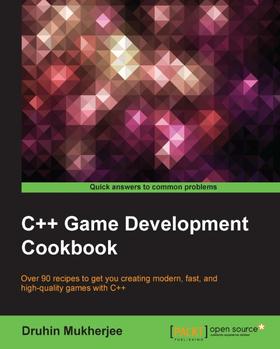
C++ Game Development Cookbook
¥334.25
Over 90 recipes to get you creating modern, fast, and high-quality games with C++About This Book·Level up your game programming skills with insightful recipes on building games in C++·Analyze the less commonly discussed problems with C++ applications to develop the best games·Improve the performance of your games with the new multi-threading and networking features of C++11Who This Book Is ForThis book is ideal for aspiring game developers who are proficient in C++ programming and are interested in developing games with C++. Some basic knowledge of game programming will be useful but is not necessary.What You Will Learn·Explore the basics of game development to build great and effective features for your game·Develop your first text-based game using the various concepts of object-oriented programming·Use algorithms when developing games with various sorting and searching techniques·Exploit data structures in a game's development for data storage·Create your first 2D game using GDI library and sprite sheet.·Build your first advanced 2D game of space invaders using patterns such as observer, fly-weight, abstract factory, command, state, and moreIn DetailC++ is one of the preferred languages for game development as it supports a variety of coding styles that provides low-level access to the system. C++ is still used as a preferred game programming language by many as it gives game programmers control of the entire architecture, including memory patterns and usage. However, there is little information available on how to harness the advanced features of C++ to build robust games.This book will teach you techniques to develop logic and game code using C++. The primary goal of this book is to teach you to create high-quality games using C++ game programming scripts and techniques, regardless of the library or game engine you use. It will show you how to make use of the object-oriented capabilities of C++ so you can write well-structured and powerful games of any genre. The book also explores important areas such as physics programming and audio programming, and gives you other useful tips and tricks to improve your code.By the end of this book, you will be competent in game programming using C++, and will be able to develop your own games in C++.Style and approachEvery recipe of this guide covers a task that will help you build different aspects of a game, such as taking player input and displaying the output, using control flow to implement decision making, and so on. Each recipe begins with gentle introduction and key concepts, has illustrated examples of use, and ends with a detailed but informative description of the inner workings.
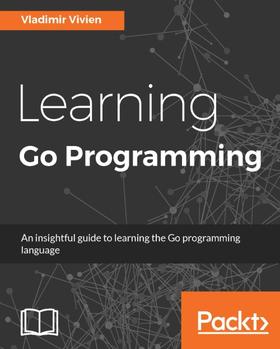
Learning Go Programming
¥371.39
An insightful guide to learning the Go programming languageAbout This Book·Insightful coverage of Go programming syntax, constructs, and idioms to help you understand Go code effectively·Push your Go skills, with topics such as, data types, channels, concurrency, object-oriented Go, testing, and network programming·Each chapter provides working code samples that are designed to help reader quickly understand respective topicWho This Book Is ForIf you have prior exposure to programming and are interested in learning the Go programming language, this book is designed for you. It will quickly run you through the basics of programming to let you exploit a number of features offered by Go programming language.What You Will Learn·Install and configure the Go development environment to quickly get started with your first program.·Use the basic elements of the language including source code structure, variables, constants, and control flow primitives to quickly get started with Go·Gain practical insight into the use of Go's type system including basic and composite types such as maps, slices, and structs.·Use interface types and techniques such as embedding to create idiomatic object-oriented programs in Go.·Develop effective functions that are encapsulated in well-organized package structures with support for error handling and panic recovery.·Implement goroutine, channels, and other concurrency primitives to write highly-concurrent and safe Go code·Write tested and benchmarked code using Go's built test tools·Access OS resources by calling C libraries and interact with program environment at runtimeIn DetailThe Go programming language has firmly established itself as a favorite for building complex and scalable system applications. Go offers a direct and practical approach to programming that let programmers write correct and predictable code using concurrency idioms and a full-featured standard library.This is a step-by-step, practical guide full of real world examples to help you get started with Go in no time at all. We start off by understanding the fundamentals of Go, followed by a detailed description of the Go data types, program structures and Maps. After this, you learn how to use Go concurrency idioms to avoid pitfalls and create programs that are exact in expected behavior. Next, you will be familiarized with the tools and libraries that are available in Go for writing and exercising tests, benchmarking, and code coverage.Finally, you will be able to utilize some of the most important features of GO such as, Network Programming and OS integration to build efficient applications. All the concepts are explained in a crisp and concise manner and by the end of this book; you would be able to create highly efficient programs that you can deploy over cloud.Style and approachThe book is written to serve as a reader-friendly step-by-step guide to learning the Go programming language. Each topic is sequentially introduced to build on previous materials covered. Every concept is introduced with easy-to-follow code examples that focus on maximizing the understanding of the topic at hand.
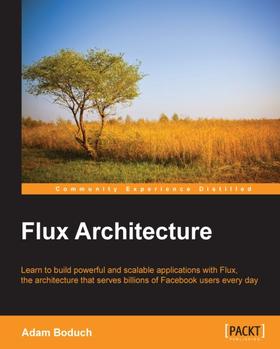
Flux Architecture
¥334.25
Learn to build powerful and scalable applications with Flux, the architecture that serves billions of Facebook users every dayAbout This Book·This the first resource dedicated to the new architectural pattern that powers Facebook·You'll learn all the tips and tricks you need to get the most out of Flux·Filled with practical, hands-on samples, you'll not only understand how Flux works, but will be able to start building Flux-powered applications straight away·Written by Adam Boduch, software architect at Virtustream (EMC), and author of JavaScript at Scale, JavaScript Concurrency, and jQuery UI Cookbook for Packt PublishingWho This Book Is ForAre you trying to use React, but are struggling to get your head around Flux? Maybe you're tired of MV* spaghetti code at scale? Do you find yourself asking what the Flux?!Flux Architecture will guide you through everything you need to understand the Flux pattern, and design and build powerful web applications that rely on the Flux architecture.You don't need to know what Flux is or how it works to read along with the book. No knowledge of Flux's partner technology, ReactJS, is necessary to follow along, but it is recommended that you have a good working knowledge of JavaScript.What You Will Learn·Understand the Flux pattern and how it will impact your React applications·Build real-world applications that rely on Flux·Handle asynchronous actions in your application·Implement immutable stores with Immutable.js·Replace React.js with alternate View components such as jQuery and Handlebars·Test and benchmark your Flux architecture using Jest—Facebook's enhancement of the Jasmine libraryIn DetailWhilst React has become Facebook's poster-child for clean, complex, and modern web development, it has quietly been underpinned by its simplicity. It's just a view. The real beauty in React is actually the architectural pattern that handles data in and out of React applications: Flux. With Flux, you're able to build data-rich applications that engage your users, and scale to meet every demand. It is a key part of the Facebook technology stack that serves billions of users every day.This book will start by introducing the Flux pattern and help you get an understanding of what it is and how it works. After this, we'll build real-world React applications that highlight the power and simplicity of Flux in action. Finally, we look at the landscape of Flux and explore the Alt and Redux libraries that make React and Flux developments easier.Filled with fully-worked examples and code-first explanations, by the end of the book, you'll not only have a rock solid understanding of the architecture, but will be ready to implement Flux architecture in anger.Style and approachThis book is filled with practical, hands-on examples. You'll not only understand how Flux works, but will be able to start building Flux-powered applications straight away.
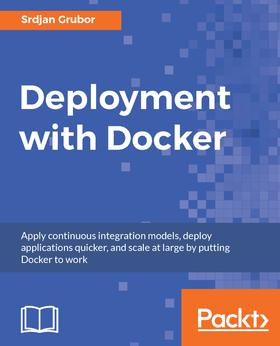
Deployment with Docker
¥297.10
A practical guide to rapidly and efficiently mastering Docker containers, along with tips and tricks learned in the field.About This Book·Use Docker containers, horizontal node scaling, modern orchestration tools (Docker Swarm, Kubernetes, and Mesos) and Continuous Integration/Continuous Delivery to manage your infrastructure.·Increase service density by turning often-idle machines into hosts for numerous Docker services.·Learn what it takes to build a true container infrastructure that is scalable, reliable, and resilient in the face of increased complexities from using container infrastructures.·Find out how to identify, debug, and mitigate most real-world, undocumented issues when deploying your own Docker infrastructure.·Learn tips and tricks of the trade from existing Docker infrastructures running in production environments.Who This Book Is ForThis book is aimed at system administrators, developers, DevOps engineers, and software engineers who want to get concrete, hands-on experience deploying multi-tier web applications and containerized microservices using Docker. This book is also for anyone who has worked on deploying services in some fashion and wants to take their small-scale setups to the next level (or simply to learn more about the process).What You Will Learn·Set up a working development environment and create a simple web service to demonstrate the basics·Learn how to make your service more usable by adding a database and an app server to process logic·Add resilience to your services by learning how to horizontally scale with a few containers on a single node·Master layering isolation and messaging to simplify and harden the connectivity between containers·Learn about numerous issues encountered at scale and their workarounds, from the kernel up to code versioning·Automate the most important parts of your infrastructure with continuous integrationIn DetailDeploying Docker into production is considered to be one of the major pain points in developing large-scale infrastructures, and the documentation available online leaves a lot to be desired. With this book, you will learn everything you wanted to know to effectively scale your deployments globally and build a resilient, scalable, and containerized cloud platform for your own use.The book starts by introducing you to the containerization ecosystem with some concrete and easy-to-digest examples; after that, you will delve into examples of launching multiple instances of the same container. From there, you will cover orchestration, multi-node setups, volumes, and almost every relevant component of this new approach to deploying services. Using intertwined approaches, the book will cover battle-tested tooling, or issues likely to be encountered in real-world scenarios, in detail. You will also learn about the other supporting components required for a true PaaS deployment and discover common options to tie the whole infrastructure together.At the end of the book, you learn to build a small, but functional, PaaS (to appreciate the power of the containerized service approach) and continue to explore real-world approaches to implementing even larger global-scale services.Style and approachThis in-depth learning guide shows you how to deploy your applications in production using Docker (from the basic steps to advanced concepts) and how to overcome challenges in Docker-based infrastructures. The book also covers practical use-cases in real-world examples, and provides tips and tricks on the various topics.
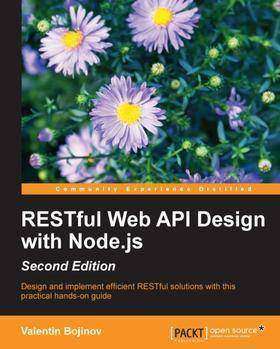
RESTful Web API Design with Node.js - Second Edition
¥222.81
Design and implement efficient RESTful solutions with this practical hands-on guideAbout This Book·Create a fully featured RESTful API solution from scratch.·Learn how to leverage Node.JS, Express, MongoDB and NoSQL datastores to give an extra edge to your REST API design.·Use this practical guide to integrate MongoDB in your Node.js application.Who This Book Is ForThe ideal target audience for this book is web developers who have some experience with RESTful services. Familiarity with basic JavaScript programming techniques is required. No prior experience with Node.JS or Express.js is required.What You Will Learn·Install, develop, and test your own Node.js user modules·Comprehend the differences between an HTTP and a RESTful application·Optimize RESTful service URI routing with best practices·Eliminate third-party dependencies in your tests with mocking·Learn about NoSQL data stores and integrate MongoDB in your Node.js application with Mongoose·Secure your services with NoSQL database integration within Node.js applications·Enrich your development skills to create scalable, server-side, RESTful applications based on the Node.js platformIn DetailIn this era of cloud computing, every data provisioning solution is built in a scalable and fail-safe way. Thus, when building RESTful services, the right choice for the underlying platform is vital. Node.js, with its asynchronous, event-driven architecture, is exactly the right choice to build RESTful APIs.This book will help you enrich your development skills to create scalable, server-side, RESTful applications based on the Node.js platform.Starting with the fundamentals of REST, you will understand why RESTful web services are better data provisioning solution than other technologies. You will start setting up a development environment by installing Node.js, Express.js, and other modules. Next, you will write a simple HTTP request handler and create and test Node.js modules using automated tests and mock objects. You will then have to choose the most appropriate data storage type, having options between a key/value or document data store, and also you will implement automated tests for it. This module will evolve chapter by chapter until it turns into a full-fledged and secure Restful service.Style and approachCreate state of the art RESTful API solutions leveraging Node.JS 4.x.
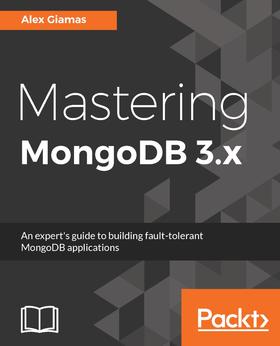
Mastering MongoDB 3.x:An expert's guide to building fault-tolerant MongoDB appli
¥259.95
An expert's guide to build fault tolerant MongoDB applicationAbout This Book·Master the advanced modeling, querying, and administration techniques in MongoDB and become a MongoDB expert·Covers the latest updates and Big Data features frequently used by professional MongoDB developers and administrators·If your goal is to become a certified MongoDB professional, this book is your perfect companionWho This Book Is ForMastering MongoDB is a book for database developers, architects, and administrators who want to learn how to use MongoDB more effectively and productively.If you have experience in, and are interested in working with, NoSQL databases to build apps and websites, then this book is for you.What You Will Learn·Get hands-on with advanced querying techniques such as indexing, expressions, arrays, and more.·Configure, monitor, and maintain highly scalable MongoDB environment like an expert.·Master replication and data sharding to optimize read/write performance.·Design secure and robust applications based on MongoDB.·Administer MongoDB-based applications on-premise or in the cloud·Scale MongoDB to achieve your design goals·Integrate MongoDB with big data sources to process huge amounts of dataIn DetailMongoDB has grown to become the de facto NoSQL database with millions of users—from small startups to Fortune 500 companies. Addressing the limitations of SQL schema-based databases, MongoDB pioneered a shift of focus for DevOps and offered sharding and replication maintainable by DevOps teams. The book is based on MongoDB 3.x and covers topics ranging from database querying using the shell, built in drivers, and popular ODM mappers to more advanced topics such as sharding, high availability, and integration with big data sources.You will get an overview of MongoDB and how to play to its strengths, with relevant use cases. After that, you will learn how to query MongoDB effectively and make use of indexes as much as possible. The next part deals with the administration of MongoDB installations on-premise or in the cloud. We deal with database internals in the next section, explaining storage systems and how they can affect performance. The last section of this book deals with replication and MongoDB scaling, along with integration with heterogeneous data sources. By the end this book, you will be equipped with all the required industry skills and knowledge to become a certified MongoDB developer and administrator.Style and approachThis book takes a practical, step-by-step approach to explain the concepts of MongoDB. Practical use-cases involving real-world examples are used throughout the book to clearly explain theoretical concepts.
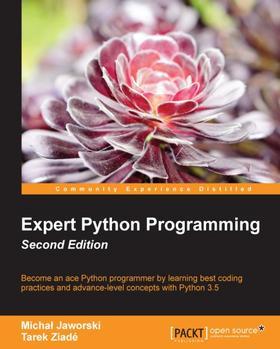
Expert Python Programming - Second Edition
¥334.25
Become an ace Python programmer by learning best coding practices and advance-level concepts with Python 3.5About This Book·Based on the latest stable version of Python (version 3.5)·Creating well manageable code that will run in various environments with different sets of dependencies·Packed with advanced concepts and best practices to write efficient Python codeWho This Book Is ForThe book would appeal to web developers and Python programmers who want to start using version 3.5 and write code efficiently. Basic knowledge of Python programming is expected.What You Will Learn·Conventions and best practices that are widely adopted in the python community·Package python code effectively for community and production use·Easy and lightweight ways to automate code deployment on remote systems·Improve your code's quality, reliability, and performance·Write concurrent code in python·Extend python with code written in different languagesIn DetailPython is a dynamic programming language, used in a wide range of domains by programmers who find it simple, yet powerful. Even if you find writing Python code easy, writing code that is efficient and easy to maintain and reuse is a challenge.The focus of the book is to familiarize you with common conventions, best practices, useful tools and standards used by python professionals on a daily basis when working with code.You will begin with knowing new features in Python 3.5 and quick tricks for improving productivity. Next, you will learn advanced and useful python syntax elements brought to this new version. Using advanced object-oriented concepts and mechanisms available in python, you will learn different approaches to implement metaprogramming. You will learn to choose good names, write packages, and create standalone executables easily.You will also be using some powerful tools such as buildout and vitualenv to release and deploy the code on remote servers for production use. Moving on, you will learn to effectively create Python extensions with C, C++, cython, and pyrex. The important factors while writing code such as code management tools, writing clear documentation, and test-driven development are also covered.You will now dive deeper to make your code efficient with general rules of optimization, strategies for finding bottlenecks, and selected tools for application optimization.By the end of the book, you will be an expert in writing efficient and maintainable code.Style and approach An easy-to-follow guide that covers industry followed best practices in Python programming
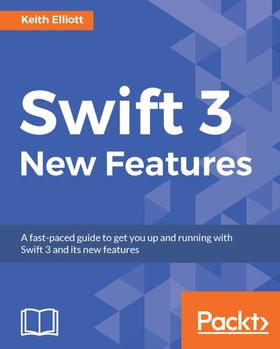
Swift 3 New Features
¥222.81
A fast-paced guide to get you up and running with Swift 3 and its new featuresAbout This Book·Get up to date with the latest changes to Swift 3·Make your life easier by knowing how to port your Swift code to the latest version·Learn how to write programs that work on most of the major platforms such as iOS and LinuxWho This Book Is ForThe book is for those who are familiar with Swift but are in need of clear guidance on what's changed in the latest version and the new features.What You Will Learn·Migrate a Swift 2.2 project to Swift 3·Understand the workings of Swift Package Manager·Interact with Cocoa libraries when importing Objective C to Swift·Explore the function and operator changes new in Swift 3·Work with the advanced type changes, attribute improvements, and floating point type improvements in Swift·Discover the changes in the Swift API and see how Objective-C can be manipulated in the current API·Implement the new features central to Swift Testing and understand the new debug features·Create server-side applications using Swift 3In DetailSince Swift was introduced by Apple in WWDC 2015, it has gone on to become one of the most beloved languages to develop iOS applications with. In the new version, the Swift team aimed to take its adoption to the next level by making it available for new platforms and audiences.This book will very quickly get you up to speed and productive with Swift 3. You will begin by understanding the process of submitting new feature requests for future versions of Swift. Swift 3 allows you to develop and run your applications on a Linux machine. Using this feature, you will write your first Linux application using the debugger in Linux. Using Swift migrator, you will initiate a conversion from Swift 2.2 to Swift 3.Further on, you will learn how to interact with Cocoa libraries when importing Objective C to Swift. You will explore the function and operator changes new to Swift 3, followed by Collection and Closure changes. You will also see the changes in Swift 3 that allow you write tests easier with XCTest and debug your running code better with new formats as well. Finally, you will have a running server written completely in Swift on a Linux box.By the end of the book, you will know everything you need to know to dive into Swift 3 and build successful projects.Style and approachThe book takes a tutorial-based approach offering an overview of the new features introduced in the latest version of Swift. It includes relevant examples of how code and concepts change when it comes to working on Swift 3 compared to previous versions.
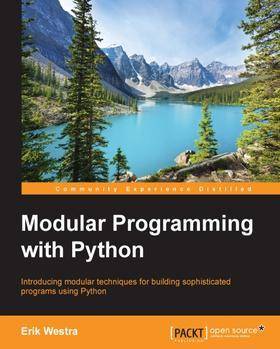
Modular Programming with Python
¥297.10
Introducing modular techniques for building sophisticated programs using PythonAbout This Book·The book would help you develop succinct, expressive programs using modular deign·The book would explain best practices and common idioms through carefully explained and structured examples·It will have broad appeal as far as target audience is concerned and there would be take away for all beginners to PythonWho This Book Is ForThis book is intended for beginner to intermediate level Python programmers who wish to learn how to use modules and packages within their programs. While readers must understand the basics of Python programming, no knowledge of modular programming techniques is required.What You Will Learn·Learn how to use modules and packages to organize your Python code·Understand how to use the import statement to load modules and packages into your program·Use common module patterns such as abstraction and encapsulation to write better programs·Discover how to create self-testing Python packages·Create reusable modules that other programmers can use·Learn how to use GitHub and the Python Package Index to share your code with other people·Make use of modules and packages that others have written·Use modular techniques to build robust systems that can handle complexity and changing requirements over timeIn DetailPython has evolved over the years and has become the primary choice of developers in various fields. The purpose of this book is to help readers develop readable, reliable, and maintainable programs in Python.Starting with an introduction to the concept of modules and packages, this book shows how you can use these building blocks to organize a complex program into logical parts and make sure those parts are working correctly together.Using clearly written, real-world examples, this book demonstrates how you can use modular techniques to build better programs. A number of common modular programming patterns are covered, including divide-and-conquer, abstraction, encapsulation, wrappers and extensibility. You will also learn how to test your modules and packages, how to prepare your code for sharing with other people, and how to publish your modules and packages on GitHub and the Python Package Index so that other people can use them. Finally, you will learn how to use modular design techniques to be a more effective programmer.Style and approachThis book will be simple and straightforward, focusing on imparting learning through a wide array of examples that the readers can put into use as they read through the book. They should not only be able to understand the way modules help in improving development, but they should also be able to improvise on their techniques of writing concise and effective code.
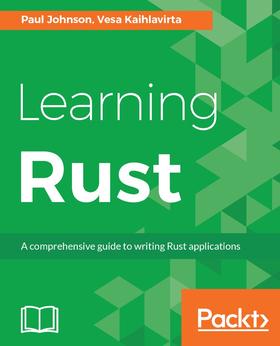
Learning Rust:A comprehensive guide to writing Rust applications
¥334.25
Start building fast and robust applications with the power of Rust by your sideAbout This Book·Get started with the language to build scalable and high performance applications·This book will help C#/C++ developers gain better performance and memory management·Discover the power of Rust when developing concurrent applications for large and scalable softwareWho This Book Is ForThe book is for absolute beginners to Rust, who want to build high performance, concurrent applications for their projects. It is suitable for developers who have a basic knowledge of programming and developers who are using the C#/C++ language to write their applications. No knowledge of Rust is expected.What You Will Learn·Set up Rust for Windows, Linux, and OS X·Write effective code using Rust·Expand your Rust applications using libraries·Interface existing non-Rust libraries with your Rust applications·Use the standard library within your applications·Understand memory management within Rust and speed efficiency when passing variables·Create more complex data types·Study concurrency in Rust with multi-threaded applications and sync threading techniques to improve the performance of an application problemIn DetailRust is a highly concurrent and high performance language that focuses on safety and speed, memory management, and writing clean code. It also guarantees thread safety, and its aim is to improve the performance of existing applications. Its potential is shown by the fact that it has been backed by Mozilla to solve the critical problem of concurrency.Learning Rust will teach you to build concurrent, fast, and robust applications. From learning the basic syntax to writing complex functions, this book will is your one stop guide to get up to speed with the fundamentals of Rust programming. We will cover the essentials of the language, including variables, procedures, output, compiling, installing, and memory handling.You will learn how to write object-oriented code, work with generics, conduct pattern matching, and build macros. You will get to know how to communicate with users and other services, as well as getting to grips with generics, scoping, and more advanced conditions. You will also discover how to extend the compilation unit in Rust.By the end of this book, you will be able to create a complex application in Rust to move forward with.Style and approachThis comprehensive book will focus on the Rust syntax, functions, data types, and conducting pattern matching for programmers. It is divided into three parts and each part of the book has an objective to enable the readers to create their own applications at an appropriate level, ultimately towards creating complex applications.




 购物车
购物车 个人中心
个人中心



